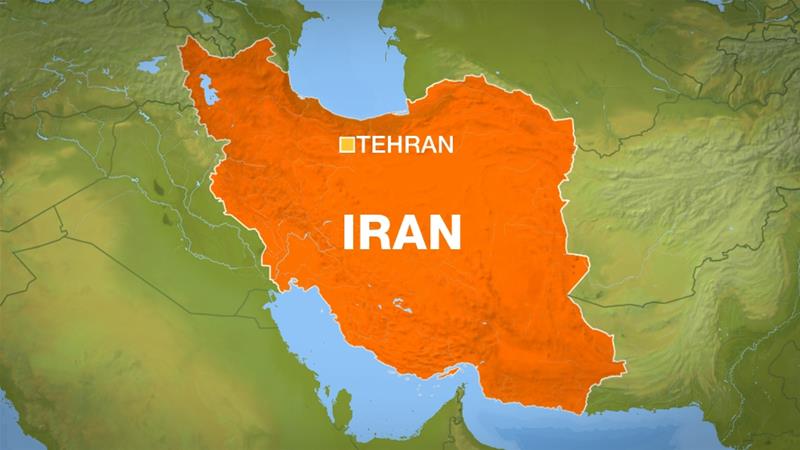About a dozen people injured in rush to leave buildings during 4.6-magnitude tremor

The epicentre of the earthquake in Iran on May 8, 2020 was near Mount Damavand, north-east of Tehran. Reuters
An earthquake near Iran's tallest mountain killed at least one person and jolted the capital Tehran early on Friday, forcing panicked residents to flee buildings.
The shallow 4.6-magnitude quake hit at 12.48am local time near the city of Damavand, about 55 kilometres east of Tehran, the US Geological Survey said.
The quake prompted scores of residents of the capital to leave buildings for the safety of streets and parks.
Health Ministry spokesman Kianoush Jahanpour said on Twitter that the tremor claimed the life of one person and injured seven.
Mr Jahanpour called on people to "keep calm" and follow safety guidelines.
Iran's semi-official Fars news agency said two people died "because of trauma and heart attack", while 13 were injured as they rushed to leave buildings.
The agency said the quake was preceded by a 2.9 tremor more than an hour earlier and was felt in the northern provinces of Mazandarn, Qazvin, Zanjan and Alborz.
The Geophysics Institute of Tehran University registered at least eight aftershocks, it said.
The USGS said on its website that the quake struck at a depth of 10km.
Its epicentre was south of Mt Damavand, a volcanic mountain which at 5,671 metres is Iran's tallest peak.
Iran sits on top of major tectonic plates and experiences frequent seismic activity.
A 5.7 magnitude earthquake that rattled the western village of Habash-e Olya on February 23 killed at least nine people over the border in Turkey.
In November 2017, a 7.3-magnitude quake in Iran's western province of Kermanshah killed 620 people.
In 2003, a 6.6-magnitude quake in south-eastern Iran destroyed the ancient mud-brick city of Bam and killed at least 31,000 people.
Iran's deadliest was a 7.4-magnitude quake in 1990 that killed 40,000 people in northern Iran, injured 300,000 and left half a million homeless.
In December and January, two earthquakes struck near Iran's Bushehr nuclear power plant.
Neighbouring countries have raised concerns about the reliability of the country's sole nuclear power facility, which produces 1,000 megawatts of power, and the risk of radioactive leaks in case of a major earthquake.
Updated: May 8, 2020

Casualties reported after 5.1 earthquake hits Iran
Two people died in capital Tehran while 22 others are injured, according to state media.

Two people have died and 22 others were injured as they fled their homes in a panic following a magnitude 5.1 earthquake that hit northern Iran early on Friday (20:18 GMT on Thursday), according to state media.
Among the dead were a 21-year-old woman in Tehran who suffered heart failure, and a 60-year-old man in the city of Damavand, east of the capital, killed by a head injury, officials said.
More:
Deadly magnitude 5.9 earthquake hits northwestern Iran
Several dead in Turkey after earthquake hits Iran border area
6.3-magnitude earthquake hits western Iran
According to the United States Geological Survey (USGS), the epicentre of the earthquake was at Damavand, just northeast of the capital, at the depth of 10km (6.2 miles).
One resident in the Iranian capital told Al Jazeera that the shaking of the ground felt "very strong".
#Tehran #Earthquake photos of people waiting in the street in the early hours by IRNA. May 8 (Thr time) #زلزله_تهران #زلزله#Iran pic.twitter.com/mVS15DCLzC— Living in Tehran (@LivinginTehran) May 7, 2020
Images posted on social media showed people huddled in the streets of Tehran in the middle of the night, as they tried to escape from the quake.
People are coming out into the streets after a 5.1 richter earthquake just hit near Tehran. Aftershocks are possible. An official in #Iran’s National Crisis Org has told people to maintain social distancing as they get out of their homes. pic.twitter.com/5E0oYc9MfJ— Sina Toossi (@SinaToossi) May 7, 2020
There were several mild aftershocks, but no serious damage from the quake that struck after midnight on the border of the provinces of Tehran and Mazandaran, authorities said.
Boulders were also seen blocking the roadway leading to the mountainous Damavand area.
Many people in Tehran have left their homes out of fear of possible aftershocks.
Officials urged people who spent the night outdoors to observe social distancing to limit spread of the coronavirus that has killed nearly 6,500 and infected more than 103,000 in Iran.
They assured the public there was no shortage of petrol as people rushed to gas stations to fill up after the quake.
Iran is one of the most seismically active countries in the world, where earthquakes occur often and are destructive.
SOURCE: AL JAZEERA AND NEWS AGENCIES
No comments:
Post a Comment